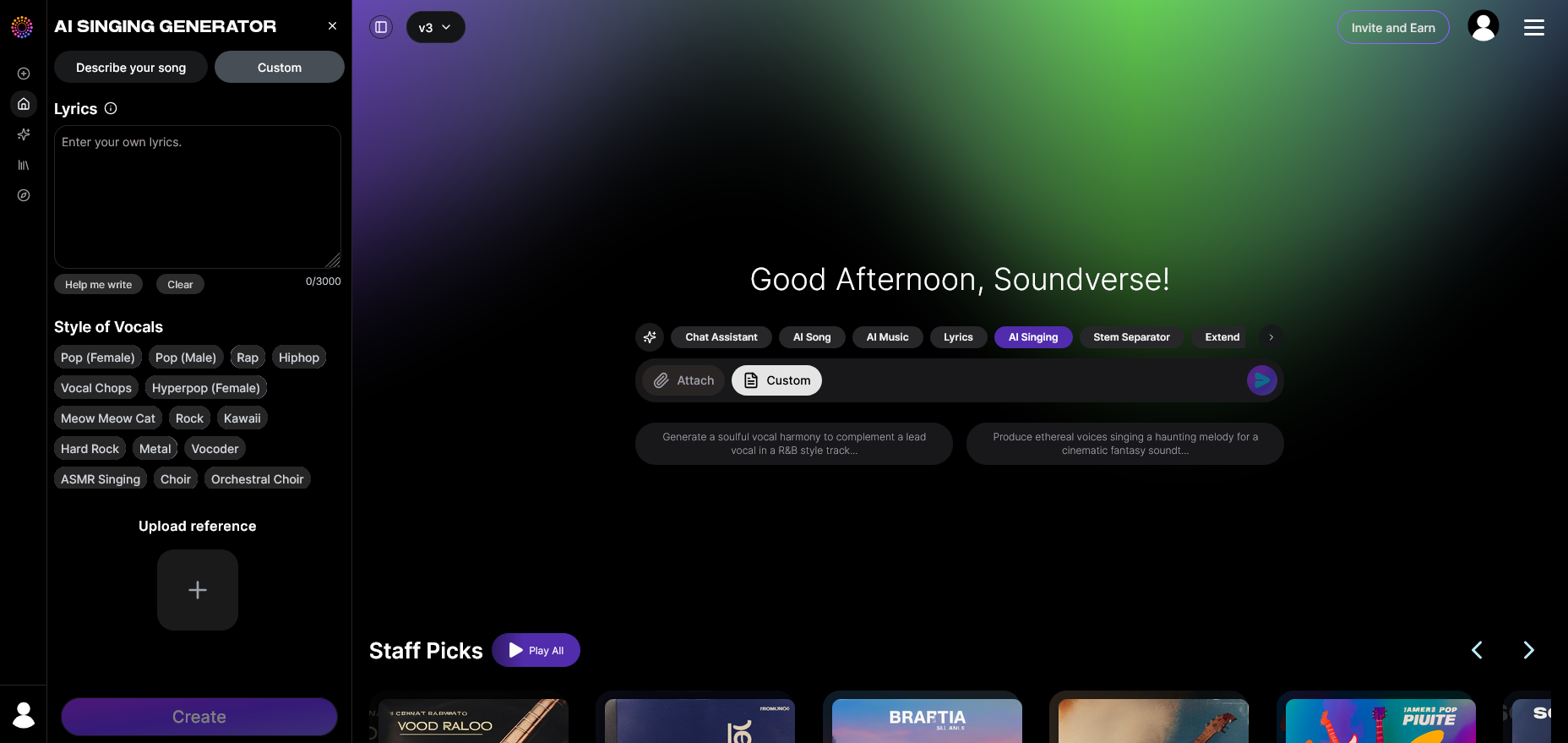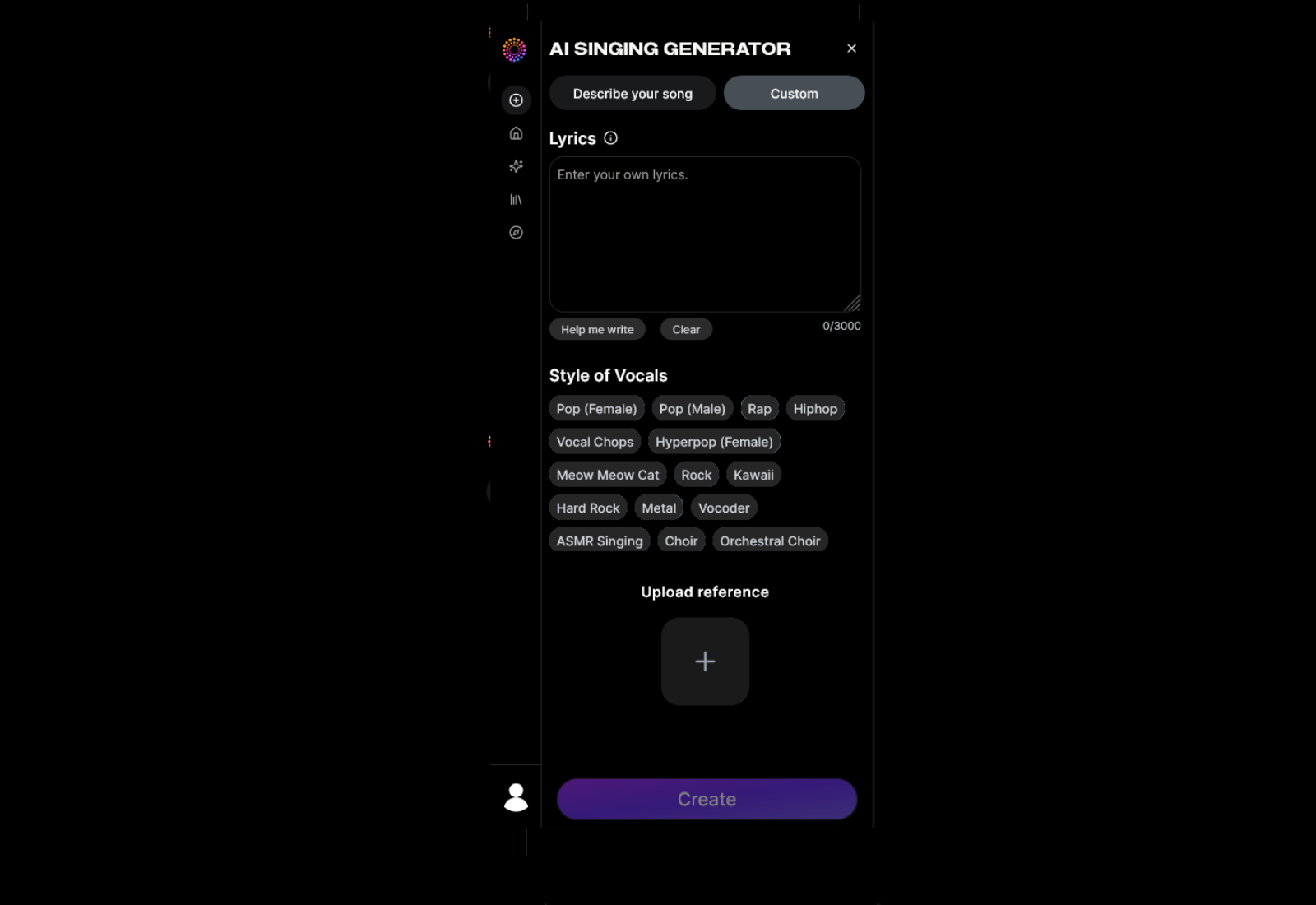Breaking Language Barriers with AI Vocals: Create Songs with Native Pronunciation
Contents
- Introduction
- How to Use the AI Singer
- Pronunciation Mastery: Genre-Specific Language Considerations
- Cultural Sensitivity in Cross-Border Music
- Real-World Applications: Who Benefits Most
- Genre-Specific Workflows
- Why This Matters for Modern Producers
- Conclusion: The World as Your Studio
Introduction
The globalization of music has never been more real. A DJ in Berlin can drop a track with Japanese hooks. A producer in Lagos can layer Spanish vocals over Afrobeats. And with AI singing tools like Soundverse AI Singer, none of it requires native pronunciation, or even a vocalist in the studio.
For years, language has shaped who gets to participate in which genres. A songwriter with ideas in one language often struggled to cross cultural borders without a native collaborator. Soundverse AI Singer changes that. With lyrics, a style choice, and a bit of reference material, creators can now generate convincing, genre-ready vocals in almost any language.
This shift is more than convenience. It's an invitation to join the global music conversation without fear of mispronunciation or cultural gatekeeping.
How to Use the AI Singer

The AI Singer is designed to make cross-cultural vocal creation effortless. When you open the tool, you'll see two options: "Describe your song" for quick experiments, and "Custom" for full creative control. For cross-language work, the Custom method gives you the precision you need.

Step 1: Input Your Lyrics
Start by typing your lyrics directly into the text field. Whether you're working in Spanish, Korean, Arabic, or any other language, input the text as you would naturally write it. If you need inspiration, the "Help me write" feature can generate lyrics in multiple languages.

Step 2: Choose Your Vocal Style
This is where genre-specific magic happens. Select from styles that match your cultural target: kawaii for J-pop influenced tracks, hyperpop for modern electronic feels, or traditional styles like Gregorian chant for more classical approaches. Each style carries its own cultural vocal characteristics.

Step 3: Add Reference Audio (Optional)
For cross-cultural work, a reference can be invaluable. Record yourself singing the melody with approximate pronunciation, or use a voice memo to demonstrate the rhythm and flow you want. The AI will interpret your reference as a creative guide while handling the linguistic precision.

Step 4: Generate and Refine
Click 'Create', and within seconds you'll have a professionally styled vocal in your chosen language. If pronunciation needs adjustment, you can refine using phonetic spelling techniques (detailed in the next section) and regenerate until it's perfect.

This streamlined workflow removes the traditional barriers to cross-cultural music creation. No need for native speakers in the studio, no complex pronunciation coaching, no international travel for collaboration. Just clear creative intent and the AI Singer's linguistic capabilities.
This workflow is what sets Soundverse apart: it's fast, intuitive, and built for experimentation. Whether you're a seasoned producer or just starting out, you can generate professional-sounding vocals without technical roadblocks.
Consult The Complete Beginner's Guide to AI Generated Vocals for more on the workflow. It is perfect for beginners, but there is a little something in there for everyone.
Pronunciation Mastery: Genre-Specific Language Considerations
Different genres demand different vocal approaches. K-pop requires crisp consonants and melodic flow. Reggaeton needs rhythmic precision with rolled R's. Bollywood calls for expressive ornamentation and clear Hindi pronunciation.
Soundverse AI Singer handles these nuances automatically, but understanding them helps you get better results:
For Spanish and Latin genres: Input "corazón" as "ko-ra-SOHN" if the AI struggles with stress patterns. Reggaeton and Latin trap benefit from emphasizing the rhythmic syllables.

For Asian languages: Korean tracks work best when you break complex words into syllables. "Saranghae" becomes "sah-rang-heh" for clearer interpretation. Japanese requires attention to vowel length, "sayonara" not "say-oh-nar-ah."
For Arabic and Middle Eastern styles: Emphatic consonants matter. If the AI misses the throaty quality, try adding phonetic hints like "kh" for the guttural sounds.
For European languages: French requires soft consonant endings. German benefits from crisp articulation. Italian flows better when you emphasize vowel sounds.
The key is experimentation. Start with standard spelling, then adjust based on what you hear. Your reference audio can guide pronunciation when text alone isn't enough.
Cultural Sensitivity in Cross-Border Music
Technology can generate convincing performances. But cultural sensitivity still matters. Using AI to blend genres and languages isn't just about sound, it's about respect.
Research before you create. Understanding a genre's cultural roots helps you experiment thoughtfully. K-pop emerged from specific social contexts. Reggaeton carries Caribbean and Latin American history. Bollywood vocals connect to centuries of Indian classical tradition.
Credit your inspiration. When you borrow vocal styles or linguistic elements, acknowledge their origins. A simple liner note or social media mention goes a long way toward showing respect.
Partner with local artists. AI can help you sketch ideas, but human collaborators bring cultural authenticity. A Nigerian producer exploring Punjabi hooks might use Soundverse for the demo, then work with a Punjabi vocalist for the final track. The AI becomes a creative bridge, not a replacement.
Soundverse's ethical foundation supports this approach. Unlike platforms trained on questionable datasets, Soundverse relies on licensed contributions through its Partner Program. Artists, libraries, and labels contribute directly, ensuring fair compensation and authenticity.
Real-World Applications: Who Benefits Most
The power of cross-cultural AI vocals becomes clear when you see who's already using it:
The Nigerian Afrobeats producer wants to add Punjabi hooks to connect with diaspora communities in Toronto and London. Traditional routes would mean flying to Punjab, networking for weeks, and hoping for chemistry. With Soundverse, they can test the concept in an afternoon, refine it over days, then decide whether to pursue human collaboration.
The Berlin techno DJ needs Japanese vocals for a track aimed at Tokyo clubs. Language barriers made this impossible before. Now they can experiment with different J-pop and J-rock vocal styles, find what works with their 130 BPM kick pattern, and deliver a culturally-aware banger.
The Mumbai hip-hop artist wants to reach American audiences with English verses while keeping Hindi choruses. Pronunciation anxiety held them back from recording English parts. Soundverse lets them practice, perfect, and produce English vocals that sound natural to native speakers.
The São Paulo reggaeton producer dreams of featuring Korean vocal chops in their Latin trap beats. K-pop's melodic sensibility could create something entirely new. With AI vocals, they can prototype these ideas without expensive studio time or complex international coordination.
In each case, the AI doesn't replace human artistry. It removes the barriers that prevent experimentation. The producer maintains creative control while accessing vocal possibilities that geography once made impossible.
Genre-Specific Workflows

Different musical styles require different approaches to cross-cultural vocals:
Electronic and Dance Music: Focus on rhythm and catchiness over perfect pronunciation. A Japanese hook in a house track needs energy more than linguistic precision. Use Soundverse's hyperpop and kawaii styles for modern electronic feels.
Hip-Hop and Trap: Pronunciation clarity matters more here. Rap experiments in Spanish or Korean need crisp consonants and natural flow. Feed in reference recordings of yourself rapping the rhythm, then let AI handle the linguistic polish.
Pop and R&B: Melodic smoothness comes first. Soundverse excels at creating polished toplines that sound radio-ready. Experiment with different vocal timbres until you find one that complements your track's emotional tone.
Rock and Metal: Power and attitude trump perfect pronunciation. Whether you're exploring opera in Italian or Mongolian throat singing, focus on the raw energy that makes these genres compelling.
The fastest workflow: sketch your idea in your native language first. Get the melody and rhythm right. Then translate and regenerate with Soundverse. This approach ensures your musical instincts stay sharp while the AI handles linguistic complexity.
Why This Matters for Modern Producers
Electronic producers thrive on novelty. A new voice texture, a fresh linguistic twist, or a vocal hook in an unexpected language can make the difference between a track that gets skipped and one that dominates playlists.
Language barriers once limited these possibilities. You either worked within your linguistic comfort zone or invested heavily in international collaborations. Soundverse changes this equation entirely.
Now you can test a dozen different cultural approaches in a single session. That Japanese hook idea? Try it. The Spanish chorus concept? Generate it. The Arabic vocal texture you heard in a dream? Make it real.
This isn't about replacing human vocalists. It's about expanding your creative palette. Use AI to sketch, explore, and refine. When you find something special, you can always bring in human collaborators to add the final polish.
Conclusion: The World as Your Studio
AI doesn't erase the need for human artistry. Instead, it expands it. With Soundverse AI Singer, music creation is no longer bounded by language, geography, or access to native vocalists. A single producer can explore dozens of genres and languages within the span of an afternoon.
Pronunciation barriers are gone. Cultural sensitivity is supported through ethical training. And real-world applications show that this isn't theory, it's already happening.
The future of international music isn't about who speaks the language best. It's about who uses technology to connect, experiment, and create across borders. With Soundverse, your next track could speak to the world. Literally.
Ready to break barriers? Sign up today and discover why creators worldwide choose Soundverse AI Singer for cross-cultural music creation.
Click below to start your free signup journey and experience the future of music creation:







